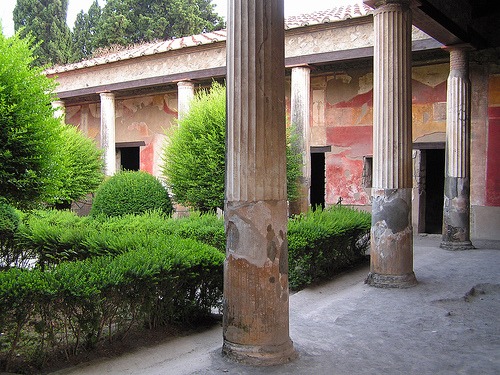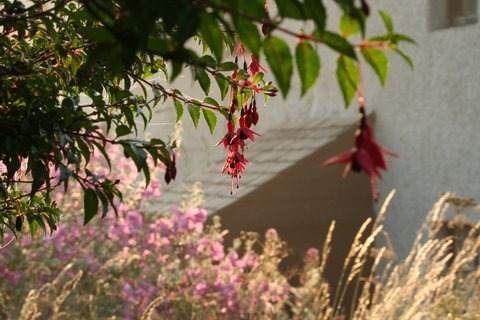
The garden of the House of Venus at Pompeii is one of the oldest surviving gardens in the world (image courtesy John Keogh)
Cultivation and the domestication of plants began in the Levantine Corridor, which runs from Dead Sea to the Damascus Basin, and quite probably outside Jericho. This is known because the earliest domesticated plants are all native to this region and radio-carbon dating reveals that horticultural activity began c9,000 BCE. Plants were cultivated by hand and with digging sticks, not with the plough, but the plants cultivated were all cereals and pulses, making ‘farming’ a better description of the activity than ‘gardening’ or ‘horticulture’ in the modern sense of ‘not ploughed’.
The first literary evidence of gardening comes from Sumer in Lower Mesopotamia. Gilgamesh mentions that his city (Uruk) was ‘one third gardens’ – but the gardens were were palm orchards. Some flowers may have been grown but the main purpose was growing food and the gardens are unlikely to have been beside houses. People lived on dry mounds (tells) and required irrigation to grow fruit and vegetables. The Garden of Eden was ‘located’ in Sumer but its status is mythological rather than historical.
China is another candidate for having made the first gardens but the only places we know of were more like National Parks than anything we would call a garden. Chinese imperial parks were fast tracts of wild landscape set aside for hunting, as at Changan. There were altars in the parks, and pavilions at a later date, and crops were cultivated but they are better described as parks than as ‘gardens’.
The next candidate country for having had the ‘world’s first garden’ is Egypt and since the Egyptians had gardens in the exact sense in which the word is now used, ‘Egypt’ is the best answer to the question ‘Where was the world’s first garden made?’ Some temple gardens (sanctuaries, like Karnak) survive in Egypt but the only representations of domestic gardens are paintings and models. The oldest garden layout known to archaeology may be at Passargadae in Iran.
So where was Europe’s first garden made? The possibilities are Crete, mainland Greece, Sicily and mainland Italy. The inhabitants of Greece (who did not speak Greek) were cultivators by 7000 BCE, which is 2000 years before the Egyptians, and practiced ornamental horticulture in classical times (500 BCE). But Europe’s first gardens in the modern sense of enclosed and planted spaces designed in conjunction with dwellings were probably in Italy – and the oldest surviving examples are certainly in Pompeii (above image courtesy John Keogh) with some of them made by Greek-speaking people.
[See also: Previous post on Asian gardens and landscapes]





 Gardenvisit.com is most grateful to Marija Calden for help with adding new gardens updating Garden Finder entries for Germany. See for example:
Gardenvisit.com is most grateful to Marija Calden for help with adding new gardens updating Garden Finder entries for Germany. See for example: